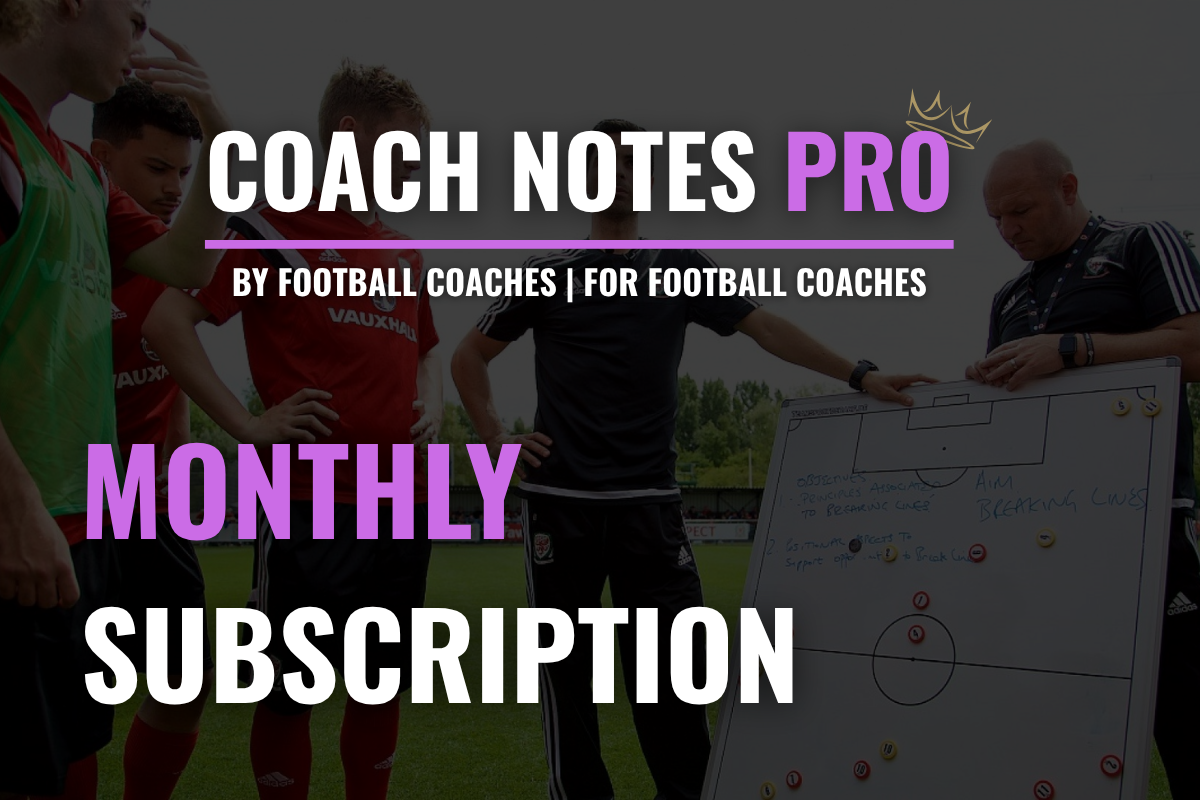
Full-Back & Wing-Back Specific Coaching
This section features 8 key areas essential to developing full-backs & wing-backs, each with tailored coaching tips and position-specific drills. Every skill is broken down to help strikers make better decisions and execute with confidence in 1v1 situations.
Defending in Wide Areas Coaching Tips
✅ Show Outside or Inside Based on Team Shape
Full backs must decide whether to force play wide or inside, depending on team structure. If midfield cover is strong, guiding the attacker inside may be safest. If isolated, showing down the line reduces risk. Use body shape and positioning to dictate where the attacker can go.
✅ Stay Low and Balanced – Ready to React
A low, athletic stance with knees bent and weight on the balls of the feet allows full backs to adjust quickly to changes in direction. Teach defenders to mirror the attacker’s body movements with short, sharp steps, avoiding lunges or flat-footed stances.
✅ Don’t Dive In – Time the Tackle
Disciplined 1v1 defending relies on patience. The key is to delay the attacker and wait for the right moment — often when they take a heavy touch or commit to a dribble. Rushing in invites mistakes. Emphasise jockeying before committing to a challenge.
✅ Use the Sideline as a Defender
The sideline is a natural boundary — use it to limit the attacker’s space. Angle your body to force the dribbler toward the touchline, reducing their options. If possible, position yourself so they can only go one way, making the tackle more predictable.
✅ Recover Quickly After Being Beaten
Even the best defenders occasionally get beaten. Full backs must be trained to recover explosively, sprinting back and re-engaging as quickly as possible. Recovery runs should aim to block crosses or delay the next action, buying time for teammates to regroup.
Overlapping & Underlapping Coaching Tips
✅ Time the Run Based on the Ball Carrier’s Action
The effectiveness of an overlap or underlap depends on timing. Full backs should start their run just as the winger or central player sets or prepares the ball, not too early. Premature runs allow defenders to track easily — late, sharp movements are harder to defend.
✅ Use Your Starting Position to Create Deception
Begin from a slightly deeper or narrower position to disguise your run. This makes it easier to accelerate into space untracked and offers the option of both an overlapping and underlapping path. Mix movements to become less predictable.
✅ Understand When to Overlap vs Underlap
Overlaps are most useful when the wide player is isolated near the touchline, while underlaps work better when there’s space inside or when defenders overcommit wide. Encourage full backs to scan ahead and choose based on available space and opposition shape.
✅ Communicate & Coordinate with the Wide Player
Non-verbal cues and verbal commands are crucial. A quick shout or signal helps the wide player know whether to drive inside, play a through pass, or set the ball. Effective combinations require chemistry and clarity between the full back and wide player.
✅ Recycle or Recover if the Ball Doesn’t Arrive
If the ball isn’t played into your run, quickly assess whether to reset possession, support from behind, or recover defensively. Full backs must remain connected to the play even after a run is not rewarded — showing discipline in recovery is as important as the initial movement.
Crossing Coaching Tips
✅ Identify the Type of Cross Based on Position & Movement
Full backs must recognise what type of cross suits the situation:
- Low cut-backs from the byline
- Whipped crosses from wide-on-the-run
- Deep floated balls from advanced build-up
Train players to adjust their technique depending on the angle, pressure, and the runs of teammates inside the box.
✅ Deliver With Purpose, Not Just Into an Area
Crosses should target specific zones or player movements — not just be aimless deliveries. Use cues like the striker’s near-post run, the timing of the late arriving midfielder, or where the space is in the defensive line. Clarity of intent in delivery increases scoring chances.
✅ Body Shape & Footwork Dictate Quality
Focus on the approach to the ball:
- Open the hips to wrap around the ball for whipped crosses
- Stay over the ball for low, driven deliveries
- Use a slightly angled foot with minimal follow-through for lofted crosses
Train these techniques under pressure to mirror game tempo.
✅ Scan Before Crossing
Encourage full backs to scan the box before crossing. A quick look helps them identify available runners, defensive gaps, or whether to delay and recycle. This habit improves crossing decision-making and avoids wasted opportunities.
✅ Deliver Under Pressure & on the Move
Crossing ability must transfer to real-game speed. Train full backs to cross while sprinting, after an overlap, or when being closed down. Add passive and active pressure to drills so they can maintain technique at high speed and under duress.
Inverting Coaching Tips
✅ Recognise the Trigger to Invert
Inverted movement must be purposeful and based on team structure. Train players to recognise specific triggers – such as the pivot dropping deep, the winger staying wide, or the centre back carrying the ball forward. The full back inverts to maintain balance, not simply to overload.
✅ Body Orientation for Quick Decision-Making
Once in central areas, body shape becomes vital. Players should adopt an open stance, scanning both sides and remaining on the half-turn to receive and distribute quickly. Encourage checking shoulders before receiving under pressure.
✅ Connect Play with Simplicity & Clarity
Inverted full backs become midfielders in possession – their job is often to link play, not to force the final pass. Focus on clean passing into midfield feet, bouncing passes into the attacking line, and offering angles for recycling or progression.
✅ Maintain Defensive Awareness
Even while inverting, the full back must stay tuned in to defensive responsibilities. Stress the need to track back instantly if possession is lost, and to cover central spaces that might be exposed due to rotations. Positional discipline is key.
✅ Combine with Positional Rotations
Inverted movement often forms part of a wider rotation. For example, if the holding midfielder drops into the back line, the full back inverts, and the winger stays high. Practise these interchanges in functional units so the full back learns to read and execute within the system.
Defending Against Wide Players Coaching Tips
✅ Scan Constantly to Track Movement Off the Ball
Full backs must develop the habit of frequent scanning when defending without the ball. Teach them to check the shoulder repeatedly to monitor overlapping runs, inside movements, or switches of play. This is vital when playing in a back four or five, especially against inverted wingers or overlapping full backs.
✅ Body Positioning to Delay and Dictate
Coach full backs to jockey rather than dive in. Position the body side-on, showing the attacker away from goal or toward a less dangerous area. Keep the distance close enough to apply pressure but far enough to react to sudden changes in direction.
✅ Maintain Awareness of Second Runs
Opposition wide players often make decoy runs to open space for overlapping or underlapping teammates. Full backs must stay alert to both the initial movement and the supporting run, ensuring communication with nearby teammates (e.g., centre backs or wingers) to pass on runners effectively.
✅ Anticipate the Cut-In or Cross
Against wingers, full backs should be trained to read body cues — is the winger preparing to cut inside onto their stronger foot, or shaping up for a cross? Use this to guide defensive positioning, either by narrowing the angle or getting tight early to block delivery.
✅ Track Runners Deep Into the Box When Required
Defensive duties don’t stop at the edge of the final third. Full backs must track wide players into the penalty area when they underlap or arrive at the back post. Build habits of deep recovery runs and defending the blind side during crosses and cutbacks.
Defending Inside The Box Coaching Tips
✅ React Immediately to Turnovers
Full backs must be mentally primed to transition instantly when possession is lost or won. In attacking transitions, this means recognising space and providing width or underlapping support. In defensive transitions, it's about sprinting to recovery positions and narrowing the pitch.
✅ Recovery Runs: Angle, Speed & Awareness
Teach full backs to recover diagonally towards the centre of the pitch when tracking back — not just towards the ball. This cuts off through balls, supports centre backs, and helps restore the defensive shape. Always scan for runners during the sprint to ensure no blind-side threats are left unchecked.
✅ Controlled Aggression in Counter-Pressing
When pressing immediately after losing the ball (counter-pressing), full backs must decide whether to engage or delay. Encourage aggressive but intelligent pressing, especially near the touchline, to either win the ball or force a backward pass and buy time for teammates to recover.
✅ Support with Overload or Width in Attacking Transition
In fast break situations, full backs and wing backs must assess whether to offer width for a switch or make an underlapping run to create central overloads. Their positioning can dictate whether the attack develops with pace or stalls — decision-making must match the game context.
✅ Communicate to Restore Team Shape
Transitions are chaotic. Full backs should lead with voice and gestures to help restore shape, whether that means calling a press trigger, directing midfield cover, or holding the line when under pressure. Vocal full backs contribute not just with actions, but by keeping the unit organised.
Defending Transitions Coaching Tips
✅ Recognise When to Drive Into Space
Train players to scan ahead before receiving and identify when the flank or half-space is unoccupied. If there’s no immediate pressure, encourage full backs to drive forward and commit opposition players, opening passing lanes or creating overloads.
✅ Use Body Shape to Invite Pressure and Beat It
Teach full backs to receive side-on and in stride, especially when facing forward. This allows for a smoother first touch and enables them to accelerate past pressing forwards or midfielders, shifting play quickly from defence to attack.
✅ Carry With Purpose
Ball carrying should be goal-oriented. Encourage players to travel with intent – looking to force a defensive action (press, drop, or shuffle) from the opposition. This breaks lines and unbalances the shape, creating gaps for inside forwards or midfielders to exploit.
✅ Time Runs to Exploit Space Behind the Line
Without the ball, full backs and wing backs must identify triggers to run beyond the midfield or defensive line. Triggers might include a central midfielder turning to face forward, a winger drifting inside, or a centre back stepping out with the ball.
✅ Decision Making at the End of the Run
The most effective ball carriers are those who know when to release. Whether it’s a cross, a cutback, a pass inside, or retaining possession, players must learn to scan while carrying the ball and make a decision before the final action, not after being closed down.
Pressing Coaching Tips
✅ Read the Triggers for Engagement
Train players to recognise common pressing cues, such as a poor first touch by the opposition winger, a backwards pass under pressure, or a sideways ball to a full back with limited support. Full backs must be mentally switched on to anticipate and act decisively in those moments.
✅ Coordinate Pressing with Teammates
Emphasise the importance of pressing as a unit, not as individuals. Full backs should press wide players aggressively when supported by a winger or central midfielder cutting off inside options, creating a wide-area trap. Communication and timing are critical.
✅ Force Play Into Predictable Zones
Coach players to use their body shape to show attackers where to go — typically toward the touchline or into a crowded area. This increases the chance of winning the ball or forcing an error. Avoid letting attackers turn inside into dangerous central spaces.
✅ Balance Risk and Recovery
While pressing high, full backs must always be aware of the space they leave behind. Coach them to judge risk vs reward, knowing when to commit fully and when to delay the opponent until help arrives. Encourage recovery sprints if the press is broken.
✅ Apply Pressure with Controlled Aggression
When pressing wide, players must engage with intensity but composure — staying on their feet, using their arms legally to slow the opponent, and timing their challenge. Slowing the ball carrier buys time for the team to reset or double up defensively.

































